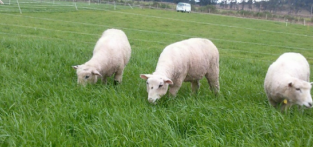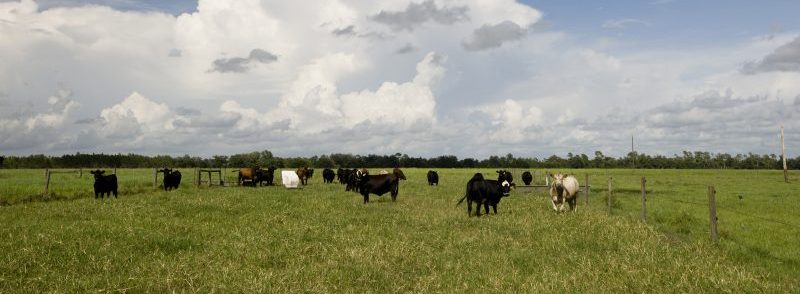Anyone who raises livestock in the Southeastern United States knows that gastrointestinal or internal parasites are a pervasive issue, particularly in Florida’s hot and humid climate. This environment necessitates year-round strategies for controlling intestinal parasites in livestock. Over the past few decades, resistance to dewormers has become increasingly problematic, especially in small ruminants such as sheep and goats. Consequently, farmers and ranchers are exploring integrated approaches to manage these intestinal parasites more effectively. Even with the use of FAMACHA systems, small ruminant producers should still seek comprehensive strategies for controlling intestinal parasites.
One of the most effective ways to suppress intestinal parasites in livestock is by allowing pastures to rest. Intestinal parasites are spread when livestock graze on areas contaminated with fecal matter containing larvae. When the animals ingest these larvae, they carry them into their gastrointestinal tracts, continuing the parasites’ life cycle. For small ruminants, the primary threat is the barber pole worm (Haemonchus contortus), one of the deadliest parasites for these animals. The lifecycle of the barber pole worm, from egg in fecal matter to infective larvae, spans just seven days. Thus, small ruminants should graze on pasture areas for less than seven days to break the lifecycle of these parasites. The larvae can survive in pastures for up to 120 days, although this period can be shorter in more tropical climates. Research indicates that in tropical environments, larvae survival may be reduced to 3-7 weeks, compared to three to nine months in temperate regions. Therefore, in Florida’s subtropical climate, resting periods for pastures can be significantly shorter. However, it is always best to consult with a local veterinarian to determine the precise time-frame for larvae survival in your specific area.
Understanding larvae survival rates and necessary pasture rest times is crucial for implementing an integrated approach to reducing intestinal parasite infestations. One effective strategy for small ruminant producers is rotational grazing. By dividing a pasture into smaller paddocks and rotating livestock through these paddocks, farmers can ensure that each paddock has sufficient rest time for larvae to die off before being grazed again. During the rest period, it is essential to have a mowing plan. Without mowing, the forage can become too mature, reducing its palatability and nutritional value. Mowing the paddock at least once during the rest period maintains a lower grass height, which helps dry out the lower stems and accelerates larvae die-off.
Another increasingly popular method is rotational grazing with alternating livestock species. Introducing cattle into the rotational grazing system can disrupt the lifecycle of intestinal parasites due to species-specific parasite host preferences. Most intestinal parasites affecting small ruminants do not pose a threat to cattle and vice versa. Thus, when cattle graze a pasture previously used by small ruminants, the larvae ingested by the cattle do not continue their lifecycle. Additionally, the grazing behaviors of small ruminants and cattle differ: Small ruminants tend to graze the upper portions of plants, while cattle graze closer to the ground. This difference means that cattle consume the larvae present in the lower canopy, effectively interrupting the lifecycle of the parasites before they can reinfect small ruminants. Cattle also help by exposing the base of the canopy to more sunlight, further deteriorating the larvae’s living conditions.
–
This method is already in practice among advanced grazing practitioners in the US, who manage both cattle and small ruminants. This has a lot of potential for small ruminant grazing, where the lack of dewormer options for barber pole worms is an issue. Typically, small ruminants graze a paddock for five days before being moved, followed by cattle grazing the same paddock for an additional 3-5 days. The paddock is then left to regrow before the cycle begins anew. This rotational grazing system leverages the different grazing habits of the livestock to reduce the presence of intestinal parasite larvae. However, successful implementation requires sufficient land and paddocks to allow for effective rotation. Proper timing is crucial for this approach to work.
While integrated approaches like rotational and species-alternating grazing can significantly reduce the population of intestinal parasites in the environment, they cannot eliminate exposure entirely. Farmers and ranchers will still need to use dewormers to treat acute infestations. However, by reducing exposure and the frequency of deworming, the risk of developing resistance to deworming medications can be minimized. In summary, adopting an integrated approach, rather than relying solely on regular deworming, can help sustain the health and productivity of small ruminant and livestock operations for years to come. Always consult with a veterinarian to develop a plan tailored to your livestock’s health needs before implementing an integrated gastrointestinal parasite control strategy.
- Managing Wild Hogs in theFlorida Panhandle: Strategies for Farmers and Landowners - October 24, 2025
- 2025 Small Ruminant Grazing Field Day – November 5 - October 3, 2025
- After an Eventful Winter, Inspect and Prepare Equipment for the Growing Season - April 11, 2025


